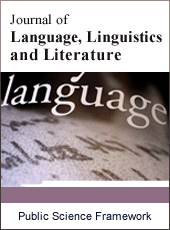Journal of Language, Linguistics and Literature
Articles Information
Journal of Language, Linguistics and Literature, Vol.1, No.5, Oct. 2015, Pub. Date: Oct. 19, 2015
A Comparison of the Effectiveness of Inductive vs. Deductive Instruction of Grammar to EFL Students
Pages: 164-169 Views: 3547 Downloads: 3859
[01]
Elham Mahjoob, English Department, Ilam University, Ilam, Iran.
The present study determines the effectiveness of inductive and deductive methods of grammar teaching on two groups of EFL students of a language institute in Shiraz, Iran. The researcher hypothesized that inductive method of teaching results in a higher learning outcome. Sixty students of the intermediate level were randomly assigned into two groups. First, a pretest was administered to both groups, after which the treatment stage, lasted 3 weeks, was performed. Getting benefit of the presence of the same teacher, 6 grammatical points adopted from targeted textbook were taught inductively to one group and deductively to the other. Soon after, a grammar test of the points taught was administered to both groups. Then the data was analyzed through t-test. Findings revealed that although there were differences in mean grade point average of both groups, no statistically significant difference was observed. There was no support for the researcher’s hypothesis.
Inductive Approach, Deductive Approach, Grammar Teaching
[01]
Abraham, R. (1985). Field independence-dependence and the teaching of grammar.
[02]
TESOL Quarterly, 19, 689-702.
[03]
Eriksson, L. (2014). The Effectiveness of Modified Inductive Versus Deductive Teaching: A case study on word order amongst a group of English as a foreign language learners. Examensarbete för kandidatexamen, 15 hp. Engelska. Web.
[04]
Erlam, R. (2003). The effects of deductive and inductive instruction on the acquisition of direct object pronouns in French as a second language. The Modern Language Journal, 87, 242-260.
[05]
Fischer, R. A. (1979) The Inductive-Deductive Controversy Revisited. Modern Language Journal, 63(3), 98-105. Retrieved from http://www.jstor.org.
[06]
Galotti, K. M. (1997). Children’s Differential Performance on Deductive and Inductive Syllogism. Journal of Educational Psychology. 58/1: 45-49.
[07]
Hammerly, H. (1975). The deduction/induction controversy. Modem Language Journal, 59, 15-18.
[08]
Herron, C., & Tomasello, M. (1992). Acquiring grammatical structures by guided induction. French Review, 65, 708-718.
[09]
Krashen, Stephen D. (1982). Principles and Practice in Second Language Acquisition. 1st Internet Ed. Pergamon Press. Web.
[10]
Nagata, N. (1997). An Experimental Comparison of Three Methods of Teaching a Programmed Unit on Exponents to Eight Grade Students. Unpublished Ph.D Dessertation. Florida State University.
[11]
Nasaji, H. & Fortos, S. (2011) Teaching Grammar in Second Language Classroom: Integrating Form-Focused Instruction in Communicative Context. New York: Routledge.
[12]
Richards, J.C, & Renandya, W.A (eds). (2002). Methodology in Language Teaching: An Anthology of Current Practice). Cambridge: Cambridge University Press. p.145
[13]
Robinson, P. (1996). Learning simple and complex rules under implicit, incidental, rule-search conditions, and instructed conditions. Studies in Second Language Acquisition, 18, 27-67.
[14]
Rosa, R., & O’Neill, M. D. (1999). Explicitness, intake, and the issue of awareness. Studies in Second Language Acqusition, 21, 511-556.
[15]
Seliger, H. W. (1975). Inductive method and deductive method in language teaching: A re-examination. IRAL-International Review of Applied Linguistics in Language Teaching, 13, 1-18.
[16]
Shaffer, C. (1989). A comparison of inductive and deductive approaches to teaching foreign languages. Modern Language Journal,73 (4), 395-403.
[17]
Silvia, A. (2006). Deductive and inductive grammar teaching. TESOL Quarterly, Vol. 40, No. 1.

ISSN Print: 2381-7054
ISSN Online: 2381-7062
Current Issue:
Vol. 6, Issue 1, March Submit a Manuscript Join Editorial Board Join Reviewer Team
ISSN Online: 2381-7062
Current Issue:
Vol. 6, Issue 1, March Submit a Manuscript Join Editorial Board Join Reviewer Team
| About This Journal |
| All Issues |
| Open Access |
| Indexing |
| Payment Information |
| Author Guidelines |
| Review Process |
| Publication Ethics |
| Editorial Board |
| Peer Reviewers |


